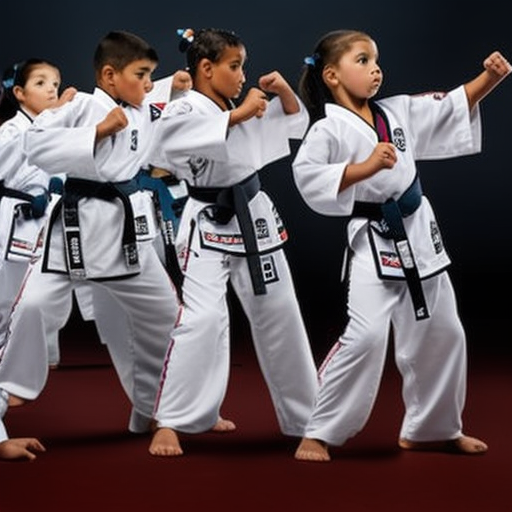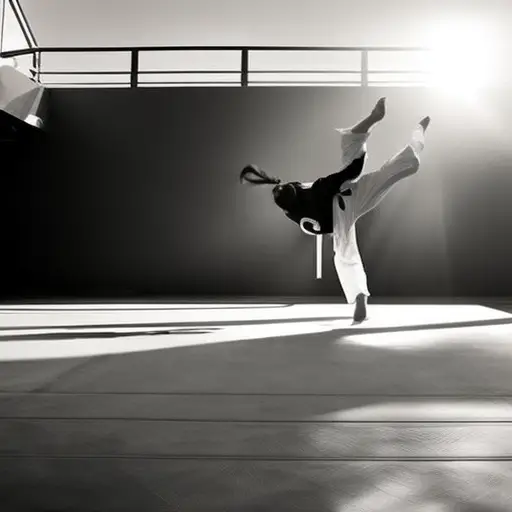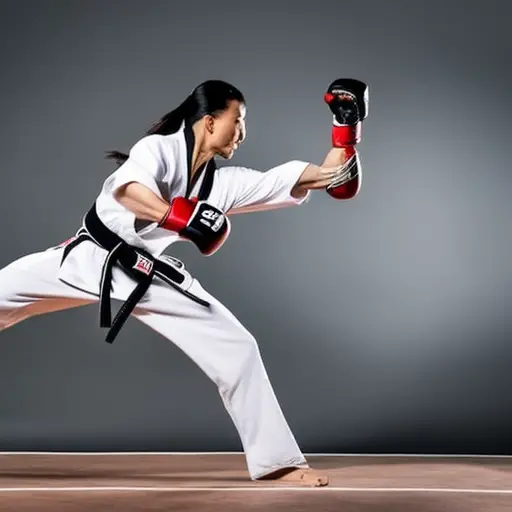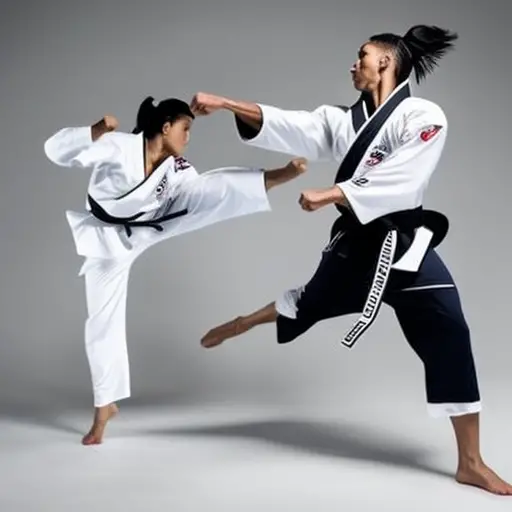Poomsae: Understanding Taekwondo Forms
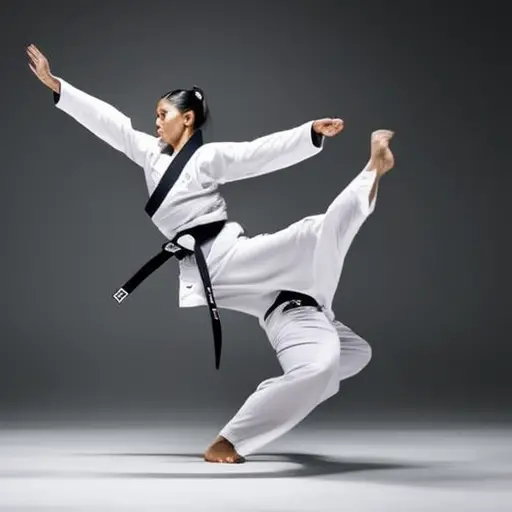
Unlock the secrets of taekwondo forms with a deep dive into the world of poomsae. Just like a choreographed dance, poomsae combines precise movements and techniques to create a powerful form of self-expression.
In this article, we will explore the origins, purpose, and benefits of practicing poomsae, as well as the various levels and variations of this discipline.
Join us as we uncover the mental and physical discipline that poomsae brings to the world of taekwondo.
The Origins and Evolution of Poomsae
As we delve into the history of poomsae, it is important to explore the origins and evolution of this fundamental aspect of Taekwondo. Poomsae, also known as forms, are a series of choreographed movements that practitioners of Taekwondo perform as part of their training. The origins of poomsae can be traced back to ancient Korea, where martial arts were deeply ingrained in the culture. Influenced by various Asian martial arts styles, including Chinese and Japanese forms, Taekwondo developed its unique set of poomsae.
The earliest forms of poomsae were simple and focused on basic techniques. Over time, as Taekwondo gained popularity and evolved into a more structured martial art, the complexity and variety of poomsae increased. The influence of other martial arts can be seen in the different styles of poomsae, such as the dynamic and acrobatic movements of the Koryo poomsae, which are reminiscent of Chinese martial arts.
The evolution of poomsae also reflects the changing emphasis of Taekwondo as a martial art. From being primarily used for self-defense, Taekwondo transformed into a sport, with poomsae becoming an essential component of competition. This shift in focus led to the development of poomsae that showcased precision, grace, and athleticism.
Understanding the origins and evolution of poomsae provides insight into the rich history of Taekwondo and helps practitioners appreciate the significance of this aspect of their training. In the subsequent section, we will explore the purpose and benefits of practicing poomsae, highlighting its role in improving techniques, discipline, and mental focus.
The Purpose and Benefits of Practicing Poomsae
One of the main purposes and benefits of practicing poomsae is the improvement of techniques, discipline, and mental focus. Poomsae serves as a vital component in taekwondo competitions, where practitioners perform a sequence of precise and controlled movements to showcase their skills and proficiency. Here are three reasons why poomsae plays a crucial role in taekwondo competitions:
-
Technical Excellence: Poomsae allows athletes to refine their techniques, ensuring correct execution of kicks, strikes, and stances. By practicing poomsae regularly, competitors develop a deep understanding of fundamental movements, enhancing their overall performance in sparring and self-defense.
-
Discipline and Mental Focus: Poomsae demands discipline and mental focus from practitioners. The intricate and synchronized movements require concentration and precision, fostering mental clarity and improving the ability to stay composed under pressure. This discipline and focus acquired through poomsae practice are invaluable in taekwondo competitions.
-
Belt Promotions: Poomsae also plays a significant role in belt promotions. Demonstrating mastery of various poomsae forms is often a requirement for advancing to the next belt level. By practicing poomsae, practitioners not only showcase their technical proficiency but also demonstrate their dedication and commitment to the art of taekwondo.
Transition: Now that we understand the purpose and benefits of practicing poomsae, let us delve into breaking down the basic techniques in poomsae to further explore its intricacies.
Breaking Down the Basic Techniques in Poomsae
The analysis of the fundamental techniques employed in poomsae provides a comprehensive understanding of the intricate movements and skillful execution required in taekwondo forms. To further explore these techniques, let’s break down the basic stances and sequence analysis commonly found in poomsae.
Basic stances are the foundation of taekwondo forms. They provide stability, balance, and power to execute various techniques. The table below illustrates four commonly used basic stances in poomsae:
| Stance | Korean Name | Description |
|---|---|---|
| Parallel stance | Naranhi sogi | Feet shoulder-width apart, parallel to each other. |
| Walking stance | Gunnun sogi | One foot in front, toes pointing forward. |
| Sitting stance | Annun sogi | Feet shoulder-width apart, knees bent at a 90-degree angle. |
| Front stance | Ap sogi | One foot in front, toes pointing forward, weight distributed evenly. |
Sequence analysis involves examining the order and continuity of techniques in a poomsae. It requires precise timing, coordination, and fluidity. By analyzing the sequence, practitioners can better understand the purpose and application of each movement.
Understanding the basic stances and sequence analysis in poomsae allows practitioners to perform with precision and grace. Now, let’s delve into the different levels and variations of poomsae, which further showcase the depth and complexity of this martial art discipline.
The Different Levels and Variations of Poomsae
Exploring the various levels and variations of poomsae unveils the intricate progression and diverse expressions within the discipline of taekwondo forms. Poomsae, a sequence of choreographed movements, is an essential component of taekwondo training and serves as a way for practitioners to showcase their skills and techniques. As individuals progress through their taekwondo journey, they encounter different levels of poomsae that challenge their abilities and deepen their understanding of this martial art. The levels hierarchy in poomsae is structured to reflect the increasing complexity and difficulty of the forms.
Here are three notable aspects of the levels and variations of poomsae that evoke emotion in the audience:
-
Striving for Mastery: As practitioners advance in their taekwondo journey, they aim to master each level of poomsae, showcasing their dedication and determination to perfect their technique.
-
Expressing Creativity: While the basic movements remain consistent, practitioners have the opportunity to add their personal touch and creative flair to the forms, allowing for individual expression within the structured framework.
-
Competing in Poomsae: Poomsae competitions provide a platform for practitioners to demonstrate their skills and compete against others from different backgrounds and styles. The intensity and excitement of these competitions highlight the significance and artistry of poomsae.
The various levels and variations of poomsae in taekwondo provide a framework for growth, self-expression, and friendly competition, making it an integral part of the art and practice.
How Poomsae Enhances Mental and Physical Discipline in Taekwondo
Developing mental and physical discipline in taekwondo is achieved through the incorporation of poomsae, as it fosters a deep connection between the mind and body. Poomsae, also known as forms, are a series of choreographed movements that practitioners perform in a specific sequence. These forms require precise execution of techniques, promoting concentration and improving focus.
Poomsae enhances mental discipline by requiring practitioners to memorize and perform complex sequences of movements. This mental challenge helps develop focus and concentration, as practitioners must remain present and focused throughout the entire form. By practicing poomsae regularly, taekwondo practitioners cultivate the ability to block out distractions and maintain a disciplined mindset.
Furthermore, poomsae also plays a crucial role in developing self-confidence. As practitioners master each movement and progress through the different levels of difficulty, they gain a sense of accomplishment and self-assurance. The repetitive practice of poomsae helps build muscle memory, improving physical discipline and coordination. This increased physical discipline then translates into increased confidence in one’s abilities.
Frequently Asked Questions
Are There Any Specific Clothing or Equipment Requirements for Practicing Poomsae?
When practicing poomsae, it is essential to adhere to specific clothing requirements, which typically include a taekwondo uniform or dobok. Wearing the appropriate attire not only ensures proper form and movement but also adds to the traditional and disciplined nature of the practice.
How Long Does It Typically Take to Learn and Master a Poomsae Form?
The learning curve of mastering a poomsae form varies depending on the individual’s dedication, previous experience, and natural ability. However, consistent practice and attention to detail can lead to improved technique, discipline, and mental focus.
Are There Any Age Restrictions for Participating in Poomsae Competitions?
Age restrictions in different martial arts vary, but for poomsae competitions, there are typically different age divisions to ensure fair competition. Participating in poomsae competitions can have numerous benefits for mental health, such as building confidence and discipline.
Can Practicing Poomsae Help Improve Flexibility and Coordination?
Practicing poomsae can have practical benefits such as improving flexibility and coordination. By engaging in the precise movements and mental focus required, individuals can enhance their physical abilities and achieve better overall performance.
Are There Any Specific Breathing Techniques or Patterns That Should Be Followed During Poomsae Practice?
During poomsae practice, it is important to follow specific breathing techniques and patterns to enhance performance and mental focus. These techniques help regulate oxygen intake, promote relaxation, and maintain a steady rhythm throughout the forms.
Conclusion
In conclusion, the ancient art of poomsae in taekwondo is an intricate and disciplined practice that has evolved over centuries.
With its origins rooted in martial arts, poomsae serves as a physical and mental training tool, allowing practitioners to develop precision, focus, and self-discipline.
Through the various levels and variations of poomsae, students can master the fundamental techniques of taekwondo, ultimately enhancing their overall physical and mental prowess.
The practice of poomsae is an essential aspect of taekwondo, providing practitioners with a profound sense of achievement and personal growth.


